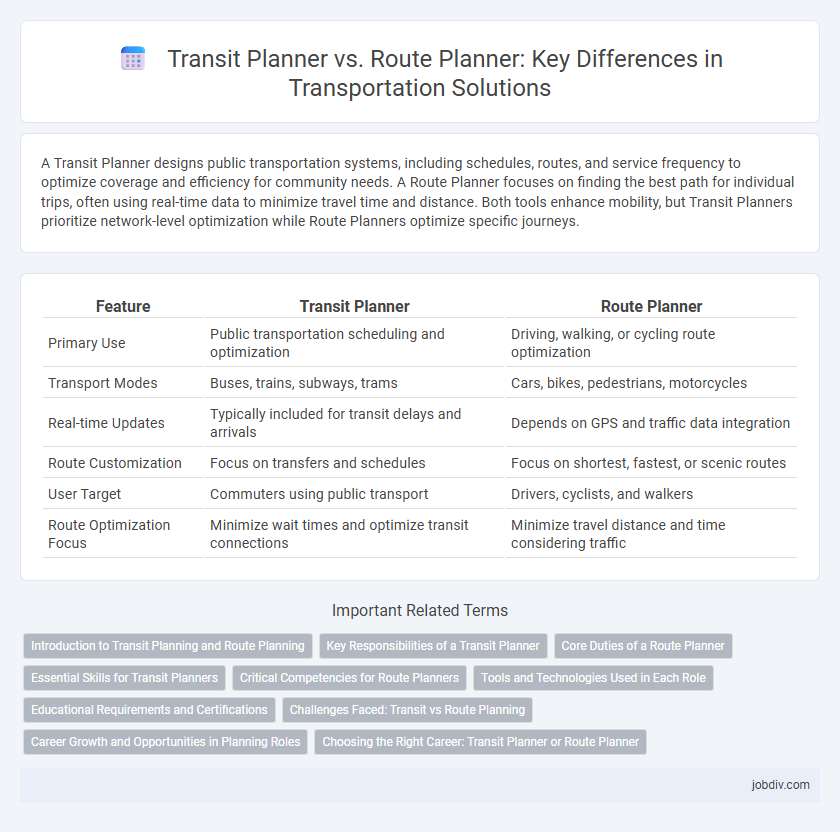A Transit Planner designs public transportation systems, including schedules, routes, and service frequency to optimize coverage and efficiency for community needs. A Route Planner focuses on finding the best path for individual trips, often using real-time data to minimize travel time and distance. Both tools enhance mobility, but Transit Planners prioritize network-level optimization while Route Planners optimize specific journeys.
Table of Comparison
| Feature | Transit Planner | Route Planner |
|---|---|---|
| Primary Use | Public transportation scheduling and optimization | Driving, walking, or cycling route optimization |
| Transport Modes | Buses, trains, subways, trams | Cars, bikes, pedestrians, motorcycles |
| Real-time Updates | Typically included for transit delays and arrivals | Depends on GPS and traffic data integration |
| Route Customization | Focus on transfers and schedules | Focus on shortest, fastest, or scenic routes |
| User Target | Commuters using public transport | Drivers, cyclists, and walkers |
| Route Optimization Focus | Minimize wait times and optimize transit connections | Minimize travel distance and time considering traffic |
Introduction to Transit Planning and Route Planning
Transit planning involves designing efficient public transportation systems, focusing on optimizing schedules, stops, and vehicle allocation to meet passenger demand. Route planning centers on determining the best paths for vehicles or individuals, emphasizing shortest distance, travel time, and traffic conditions. Both processes use data analytics and geographic information systems (GIS) to enhance mobility and reduce operational costs.
Key Responsibilities of a Transit Planner
Transit planners specialize in designing and optimizing public transportation systems, focusing on scheduling, route efficiency, and passenger demand analysis. Their key responsibilities include coordinating with transit agencies, conducting ridership studies, and developing policies to improve service accessibility and sustainability. Unlike route planners who primarily focus on creating specific travel paths, transit planners take a broader approach to urban mobility and infrastructure planning.
Core Duties of a Route Planner
A route planner is responsible for designing the most efficient travel paths by analyzing traffic patterns, distances, and traveler preferences to optimize time and costs. Core duties include mapping out multiple route options, integrating real-time data for updates, and coordinating with transit schedules to ensure seamless connections. This role focuses primarily on logistical optimization and operational efficiency within transportation networks.
Essential Skills for Transit Planners
Transit planners require proficiency in public transportation systems, data analysis, and urban mobility trends to design efficient transit networks. Route planners focus on optimizing specific travel paths using geospatial tools and traffic pattern analysis to reduce travel time and costs. Mastery of scheduling software, stakeholder coordination, and regulatory compliance is essential for transit planners to ensure service reliability and accessibility.
Critical Competencies for Route Planners
Route planners excel in spatial analysis, leveraging Geographic Information Systems (GIS) to optimize paths based on real-time traffic and distance metrics. Critical competencies include advanced problem-solving skills, proficiency in transportation modeling software, and the ability to integrate multimodal transit options efficiently. Mastery in data analytics enables route planners to adapt dynamically, improving route accuracy and minimizing delivery times.
Tools and Technologies Used in Each Role
Transit planners utilize Geographic Information Systems (GIS) and real-time data analytics to design efficient public transportation networks, integrating multi-modal transit options and demographic data for optimized service coverage. Route planners rely heavily on advanced algorithms, GPS technology, and route optimization software to determine the most efficient paths for individual vehicles, focusing on minimizing travel time and fuel consumption. Both roles employ digital mapping tools and predictive analytics but differ in scope, with transit planners addressing large-scale network planning while route planners concentrate on operational-level decisions.
Educational Requirements and Certifications
Transit planners typically require a bachelor's degree in urban planning, transportation engineering, or a related field, with many employers preferring a master's degree for advanced roles. Route planners often hold degrees in logistics, supply chain management, or geography, emphasizing practical skills in routing software and optimization techniques. Certifications such as the American Institute of Certified Planners (AICP) credential benefit transit planners, while route planners may obtain Certified Supply Chain Professional (CSCP) or Transportation Management certifications to enhance their expertise.
Challenges Faced: Transit vs Route Planning
Transit planners confront complex challenges such as integrating multiple modes of public transportation, managing varying schedules, and addressing real-time disruptions that affect passenger flow. Route planners focus on optimizing paths for individual or freight travel, overcoming obstacles like traffic congestion, road closures, and dynamic routing needs. Both face difficulties in balancing efficiency, cost, and user preferences while adapting to changing urban infrastructure and environmental factors.
Career Growth and Opportunities in Planning Roles
Transit planners specialize in designing and managing public transportation systems, offering career growth through roles in urban development and government agencies focused on sustainable mobility. Route planners concentrate on optimizing delivery or travel routes, providing opportunities in logistics, supply chain management, and private sector firms. Both career paths demand analytical and spatial skills, but transit planning often leads to strategic urban infrastructure roles, while route planning suits operational efficiency and technology-driven positions.
Choosing the Right Career: Transit Planner or Route Planner
A Transit Planner focuses on designing and improving public transportation systems, emphasizing accessibility, scheduling, and urban mobility to enhance community connectivity. A Route Planner specializes in optimizing specific travel paths for efficiency and cost-effectiveness, often working in logistics or delivery services. Choosing between these careers depends on your interest in strategic urban development versus detailed operational management within the transportation sector.
Transit Planner vs Route Planner Infographic

 jobdiv.com
jobdiv.com